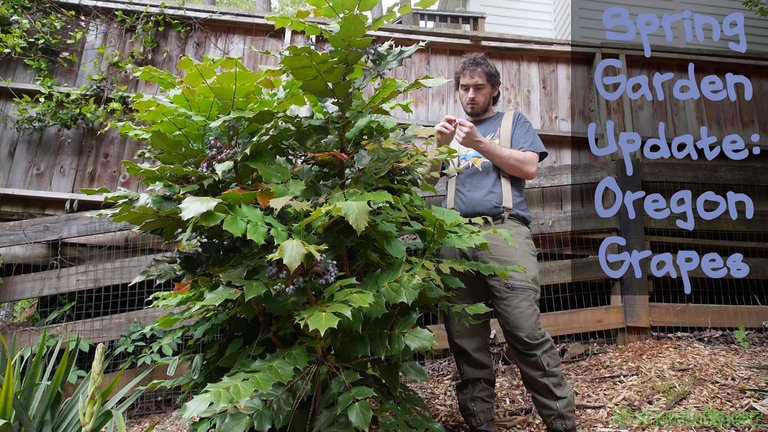Spring Garden Update: Oregon Grapes

When I moved to Georgia I would see this evergreen plant in the forests and sometimes in peoples yards. I did not learn till years later that the berries it produces are edible. A follower of mine @goat-girlz mentioned they are indeed edible and can be used to make a jam. She goes on saying they can be found throughout the forests in Oregon, probably where it got its name. Georgia shares similar climates to Oregon in some areas so makes sense it grows in both places.
I made the jam last year and it had a flavor like Cranberries. The jam was a dark crimson red color and only yielded a few tablespoons once cooked down. If eaten raw they can be very sour like a lemon. This spring the plant flowered and produced fruit again, but I must be quick as the birds will eat them all the day they are ripe. They turn a dark blue color when ripe and feel a little soft.
These plants are like hollies with stiff pointy leaves, care needs to be taken handling them as they can pierce the skin. The plants I bought have been around for about five years now and are really starting to leaf out. I moved one of them as I planted both of them too close together when I got them. Moving one about a hundred feet away from the other. Interestingly when I pulled up one of the plants, I found the roots a bright yellow color like Turmeric. Not something I see much and found it interesting.
Oregon Grape also known as a Leatherleaf Mahonia is a great plant for my Bees. The flowers form in late winter and open usually a week or so before the Solitary Bees emerge. Since not much else is flowering at the time the Bees tend to cover this plant and really do a good job pollinating them and making fruit appear all over the plant.
The plant has origins from mainland China and Taiwan and was brought to Europe at some point and then found its self in America.
LBRY Video Link
Plant profile:
https://davesgarden.com/guides/pf/go/56715/#b
Addresses below to help me buy better camera equipment and support me to travel to locations to do photo and video and overall great blogs in new places. I would be happy to list some of the contributors in my posts for donations that help me along the way.
| Coin | Address |
|---|---|
 BTC: BTC: | bc1qhfmvd2gywg4fvrgy2kkkkyqta0g86whkt7j8r7 |
 LTC: LTC: | ltc1qdyzm5cwgt8e2373prx67yye6y9ewk0l8jf3ys9 |
 DASH: DASH: | XkSqR5DxQL3wy4kNbjqDbgbMYNih3a7ZcM |
 ETH: ETH: | 0x045f409dAe14338669730078201888636B047DC3 |
 DOGE: DOGE: | DSoekC21AKSZHAcV9vqR8yYefrh8XcX92Z |
 ZEN: ZEN: | znW9mh62WDSCeBXxnVLCETMx59Ho446HJgq |
1 !BEER Token for you
Hah thanks
Sorry, you don't have enough staked BEER in your account. You need 24 BEER in your virtual fridge to give some of your BEER to others. To view or trade BEER go to hive-engine.com
The root bark is also used as a tea for allergies. We have the stuff littering our farm. The whole Pacific Northwest seems to be covered in it. The hardest part for me is to make sure the bugs don't get to the berries. Almost every time I have tried to harvest berries the majority of them have holes and bugs. It makes a tasty jam/jelly though.
Oh nice I'll keep that in mind for a tea. Hah yeah I bet ya do, it's all over the place in Georgia as well.
Damn that sucks with the bugs. The last time I harvested them I didnt find any inside but hope I don't need to start worrying about bugs in them.
We have some of that. Didn't know the berries were edible. We're not really into making jam, but I could offer them to people around here.
Oh cool, I guess they have spread around the world by now. Yeah they are easy to pick but you gotta be careful not to be poked by the sharp leaves.
Thank you for posting to the ecoTrain community! Your post has been featured in our What's Up! Curation. You can check it out and maybe discover some new like minded people at:
https://peakd.com/hive-123046/@ecotrain/what-s-up-from-the-ecotrain-community-on-hive-11-amazing-people-and-posts-here